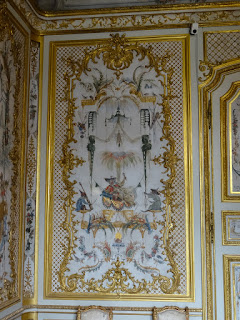Une belle journée in Chantilly. Parte 3
When the Bastille fell in 1792 the collections in Chantilly
were seized and transported to The Louvre in Paris, then the chateau was used
as a prison before being demolished in 1799. During the destruction, the reliquary
containing the hearts of all the past princes was thrown into a ditch where a
local innkeeper discovered it and hid it away until the monarchy was restored. After
several more changes of hands, often ending in executions, it finally passed on
to Henry d'Orleans, Duc d'Aumale in 1830. Fifth son of King Louis Philippe, it
is his restorative work that created the current mansion.
His art collection is second only to the Louvre in content
and breadth - the library alone contains more than 19,000 works including the best
set of illuminated manuscripts in the country. It is also the only museum in France
to hold 3 paintings by Raphael, each considered a masterpiece. Much of his
collection was acquired while he was in exile in London, and many pieces were
regained due to his position as son of the king, empowering him to demand works
stolen during the Revolution. The house was completely renovated between 1875
and 1885. Upon his death he bequeathed the estate to the Insitut de France with
the specific binding commitments that none of the works would ever leave the premises
on loan, or for any reason. And that every painting must remain in its original
wall location.
You follow the original carriage path up to the main
entrance. To your left, a huge lake that winds its way around the Château and
back towards the formal gardens. To your right is the Château d’Enghien, built
in 1769 to provide lodging for the guests of Louis Joseph, Prince of Condé and
renamed for Louis Antoine, Duke of Enghien who lived there with his nurses as
an infant. The latter Louis was charged with treason against Napoleon and
executed in Paris at the Château Vincennes.
The tour of the chateau consists of three loops, one through
the art collection, another through the private rooms and library of the Duc,
one more through the chapel. As expected, the furnishings, decorations and various
trappings were completely over the top. It was easy to see why the art
collection is second only to the Louvre - it was quite extraordinary. I made it
a point to find the 3 Raphaels and as expected, they were beautiful. The library
was impressive, so many books that you were tempted to pull a few off the
shelves to see if they were all real. The apartments were not to my taste, too
much gold and too much white. One room was dedicated to Asian-style art that
was popular for a time among the aristocracy, depicting monkeys dressed as
humans and doing human things. There was one entire gallery in the living
quarters devoted to huge paintings celebrating the family’s military victories.
The chapel was quiet and understated, and built around the reliquary full of
prince hearts, residing in a place of honor high up above the modest altar.
Quite an eyeful, especially after the subdued presentation
of the horse museum.
It was approaching train time, so we headed back through the
woods to the station. I make this sound simple, but of course it wasn’t. A dark
spiderweb of unlabeled trails winding through the enormous forest. We hadn’t
gone back the way we came out because it was well out of our way from where we’d
ended the tour of the château and it appeared to be more logical to find another
way. Logic sometimes disappoints, but we did find our way out of the maze and
ended up just across the street from the train station. And just missing the
5:30 train for lack of a ticket and about 2 minutes time. The next one came 28
minutes later and so we were on our way.
For dinner we tried something new, a Gascon restaurant a few
blocks away. Interesting place - specializing in the food of southwest France,
the menu was heavy on duck as one might expect. The décor was 1960’s living
room – dark furniture, checkered tablecloths, gilt lamps, with toasters shared
between tables for warming your bread. The lack of music made the place kind of
oppressive - everyone was speaking in hushed tones, which isn’t necessarily bad
but made the atmosphere more library than brasserie. There was one other table
by us and a medium-sized party in a room behind me. The owner was probably in
his mid-60’s and wearing a red Mr. Rogers cardigan. Nice guy but quite dour and
the sole worker, taking orders, filling glasses, explaining dishes. MLW ordered
a duck and mashed potato casserole that wasn’t available due to lack of mashed
potatoes. I ceded my duck with orange sauce to her and ordered duck with a
black truffle sauce. After taking our orders, he said, “The French people like
their duck quite rare.” We insisted that we did too. The meals came quickly and
were extraordinary - small simple green salad, over-browned sliced potatoes,
the most perfect magret de canard you
can imagine. And rare! We passed on dessert, paid up and bid the owner good night.
















































Comments